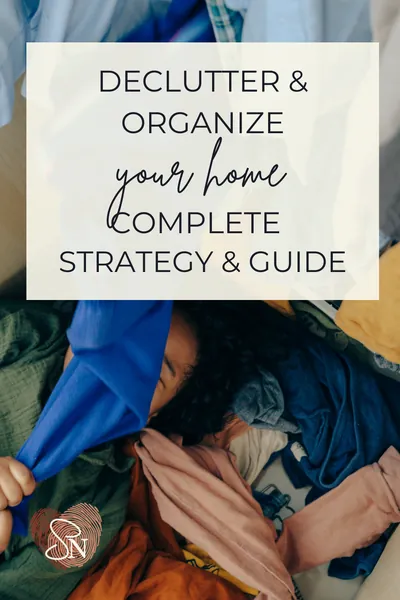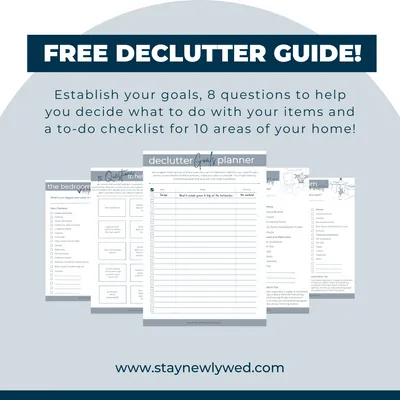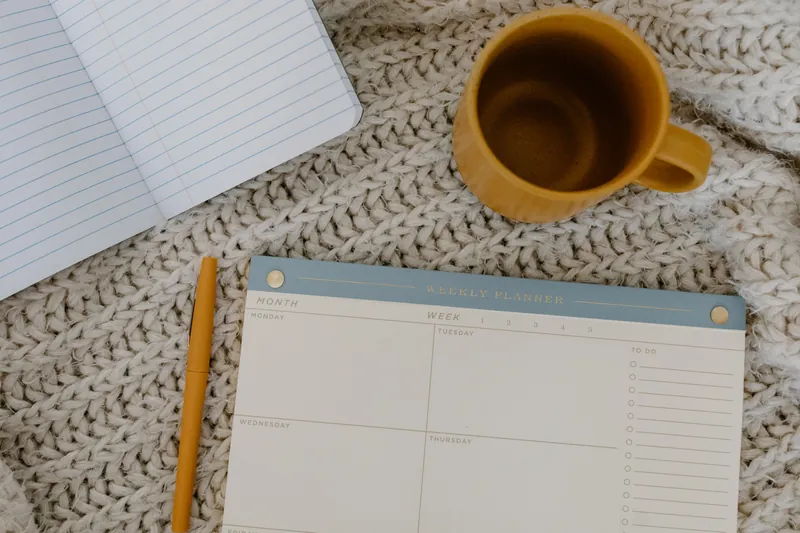Home management is a crucial aspect of maintaining a happy and well ordered household, but it’s easy to quickly get overwhelmed.
One key element of effective home management is to declutter and organize your home. Decluttering not only helps create a visually appealing space but also promotes mental clarity and reduces stress.
Let’s explore why it is important to declutter your home, how to get started, how to make a plan, useful tips for decluttering and organization, strategies for each room, and ways to involve your spouse in the process.
You should find all the tools you need to create a practical strategy that is personalized and easy to stick with. Our goal is to help you find a heading and feel empowered to complete it!
Why it’s important to declutter your home
Living in a cluttered environment can have a negative impact on your overall well-being. A disorganized space can actually be an energy zapper and I don’t think many of us need help in that department!
Raise your hand if clutter makes you feel overwhelmed? Yeah me too. It’s hard to work or even enjoy a day off when I’m surrounded by stuff.
All that extra stimuli around us is actually proven to hinder productivity, cause stress and even increase feelings of depression. When you constantly feel like nothing is ever done, clutter might even keep you from being able to enjoy time with your spouse - or bring up resentment for tasks left undone.
Yikes.
On the other hand, decluttering your home can give you a great gift - a sense of calm and the ability to enjoy your home. Organization increases your focus and can enhance your quality of life. With a decluttered and organized living space, you will be able to focus on the moment with your spouse.
Where to start decluttering your home
Getting started with decluttering may feel overwhelming, but breaking it down into smaller tasks can make the process more manageable. The biggest effort will be at the beginning. Once you’ve achieved your baseline it will be much easier to maintain!
But first thing’s, first: you need to set your goals. It won’t be enough to say “I want to declutter the house.”
We suggest making a list of every area you want to declutter. Identify your specific pain points, a completion timeline and any notes you want to include. You might start by prioritizing areas that give you the most frustration. Maybe it looks like this:
Decluttering Goals:
- Front closet, done before guests come for dinner Friday (need to make room for coats!).
- Bedroom dresser and closet, done Sat afternoon, can sort through clothes while finishing Ted Lasso.
- Garage, next weekend, is supposed to be nice outside.
- Kids toyroom, next month - need to start slow
It doesn’t have to be fancy at all!
In fact, we’ve done a lot of the work for you. You can download our Declutter Your Home Guide to get started! It includes a goal sheet, 15 questions to help you decide what to do with your items and a to-do checklist for 10 areas of your home!
How to remove the clutter
Now that you’ve identified what you need to do to declutter your home, it’s time to get practical.
You’re staring at that front closet. The shoes are piled sky high, your winter gear is haphazardly thrown on the shelf and you’re pretty sure your high school letterman jacket is in there somewhere.
Here are the 5 steps we use to move through the declutter process
Take everything out of that space and assess each item individually.
Ask yourself:
Do I need this? Do I use it? Be honest with yourself and set aside items that no longer serve a purpose or hold sentimental value. (You can get 15 questions to help you decide here!)
Use piles or boxes to identify what goes and what stays.
The piles might include: Keep, Donate, Recycle, Sell, Fix, Trash, Undecided. This system provides clarity and makes decision-making easier.
Organize as you put your keep pile away.
Don’t just throw all your “keep” shoes back in the closet. Put them back in a nice order or invest in a shoe rack to help them stay organized.
Follow through to the end.
If you labeled something to be donated, follow through by taking it there. By finishing what you started, you will avoid moving clutter from one area to another!
This step-by-step approach will help you stay focused and motivated throughout the process. Don't forget to celebrate small victories along the way!

10 Tips for decluttering and organization
Use our 10 best tips for decluttering and organization to implement a thorough decluttering plan!
Get your home to baseline
Unless you’ve got plenty of time and are super ambitious, take small bites out of this big task. Utilize your goals and timelines to keep yourself accountable.
Start with the easiest areas
Begin with spaces that require minimal decision-making, such as a hallway or a bathroom. This will build momentum and give you a sense of accomplishment.
Do one room at a time
Like I said before, take small bites of this big task. Don’t assume you can or should get your entire house finished in one weekend. Taking it space by space will help avoid burnout and give you a clear head each time you decide what you’re throwing away.
Add decluttering to your calendar
Since we’ve gotten our house to baseline, the ongoing maintenance doesn’t take too long. We declutter twice a year and we have it as a repeatable calendar event so we don’t miss it! Depending on the size of your home and if you have kids, you may need to declutter more or less often.
Make decluttering a daily mindset
Train yourselves to make decisions in between your routine decluttering. We have a donation box in our garage so anytime we decide we no longer need a certain item we can add it to our collection. That way we’re not waiting until the next time we declutter to clear it out of our space.
Adopt the one in, one out rule
We bring new things into our home almost every day. Think about implementing a one in, one out rule. So if you bring home a new kitchen towel, toss one of your stained ones. This can be especially beneficial for clothes or toys. This ensures that clutter doesn't accumulate over time.
Set limits
Determine the amount of space you have available for specific items. For example, limit yourself to a certain number of books on a shelf or clothes in a closet. This prevents overcrowding and promotes intentional consumption.
Clean out your storage
Do you ever ask yourself “what is in that box?” and then just leave it there for another day? Add your storage areas to your declutter routine. Keep things like sentimental or family heirloom items, baby supplies for the next one, important papers and seasonal decorations. Consider parting with the box of old electronics or broken things that you held onto just in case you might need them - if you ask the right questions, you’ll know what to keep or what to part ways with!
Be entertained!
Turn on your favorite playlist or podcast. You might even have your comfort show going in the background. Listening to something you enjoy can motivate you to keep going or keep you from thinking too hard about whether to donate or keep an item. And it will definitely make your decluttering feel much more enjoyable!
Involve your spouse in the process
Decluttering and organizing your home should be a collaborative effort, involving both you and your spouse. You likely both have areas that are “yours,” things of sentimental value and a system for keeping your belongings in order.
Start by having an open conversation about the importance of decluttering and how it can benefit both of you. Set aside dedicated time to work together on specific areas or tasks. Assign roles and responsibilities, taking into account each other's strengths and preferences. Don’t discard your spouse’s belongings without discussing it first.
Encourage each other by emphasizing the positive outcomes of decluttering, such as a more peaceful and harmonious living space. Recognize and appreciate their contributions to motivate them throughout the process.
For more tips on home management and ways to involve your spouse, check out these articles on creating a realistic cleaning schedule and meal planning for married couples.
Remember, decluttering and organizing your home is a continuous journey rather than a one-time task. It requires consistent effort and maintenance. By taking small steps and implementing the strategy that you create, you can transform your living space into a peaceful and enjoyable clutter-free home.





